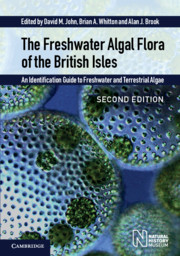 The Freshwater Algal Flora of the British Isles
The Freshwater Algal Flora of the British Isles Published online by Cambridge University Press: 12 January 2024
Introduction
The Bacillariophyta are a highly distinctive group of algae which exist as single cells, colonies or filaments. Their characteristics, as seen under the light microscope, include a unique cell wall of silica (termed a ‘frustule’) and golden-brown plastids, caused by the presence of the carotenoid fucoxanthin alongside chlorophylls a and c2. The diatom frustule is essentially of two parts, each having a valve adjoined by one or more girdle bands (termed ‘cingula’) that allow for expansion and cell division. When seen in a medium of high refractive index, the valves are extremely beautiful and this has attracted microscopists to their study almost since microscopes were invented. The vegetative cells lack flagella, but some diatoms are capable of gliding across surfaces, using a longitudinal slit in the valve termed a ‘raphe’. The Bacillariophyta are also characterized by several features visible only with electron microscopy: these are described at greater length in Round et al. (1990) and Hoek et al. (1995). Two main groups of diatoms are recognized: centric diatoms, which are radially symmetrical, and pennate diatoms which show longitudinal symmetry in at least one of three planes. The arrangement of the frustule around these planes is an important diagnostic character for pennate genera. The arrangement of structures on the valve surface also plays an important role for identifying both genera and species. These structures include the raphe, as well as many smaller perforations through which the diatom is connected to its environment.
Microscopists have studied diatoms since the late 1700s. However, the small size of the cells (most are <30 μm) coupled with the reliance on distinguishing surface ornamentation has meant that developments in diatom taxonomy have been limited by the technology available. The invention of apochromatic lenses and phase contrast techniques, the availability of better light sources and the development of mountant with high refractive indices all contributed to the ease with which features could be observed and species distinguished. This evolving taxonomic interpretation has caused many name changes – with lumping, splitting and recombination of both species and genera. The first comprehensive account of freshwater diatoms from the British Isles was W. Smith’s A Synopsis of the British Diatomaceae, published between 1853 and 1856. This included 43 genera and 284 species.
To save this book to your Kindle, first ensure [email protected] is added to your Approved Personal Document E-mail List under your Personal Document Settings on the Manage Your Content and Devices page of your Amazon account. Then enter the ‘name’ part of your Kindle email address below. Find out more about saving to your Kindle.
Note you can select to save to either the @free.kindle.com or @kindle.com variations. ‘@free.kindle.com’ emails are free but can only be saved to your device when it is connected to wi-fi. ‘@kindle.com’ emails can be delivered even when you are not connected to wi-fi, but note that service fees apply.
Find out more about the Kindle Personal Document Service.
To save content items to your account, please confirm that you agree to abide by our usage policies. If this is the first time you use this feature, you will be asked to authorise Cambridge Core to connect with your account. Find out more about saving content to Dropbox.
To save content items to your account, please confirm that you agree to abide by our usage policies. If this is the first time you use this feature, you will be asked to authorise Cambridge Core to connect with your account. Find out more about saving content to Google Drive.